TWEAK affects keratinocyte G2/M growth arrest and induces apoptosis through the translocation of the AIF protein to the nucleus
- PMID: 22438963
- PMCID: PMC3306430
- DOI: 10.1371/journal.pone.0033609
TWEAK affects keratinocyte G2/M growth arrest and induces apoptosis through the translocation of the AIF protein to the nucleus
Abstract
The soluble TNF-like weak inducer of apoptosis (TWEAK, TNFSF12) binds to the fibroblast growth factor-inducible 14 receptor (FN14, TNFRSF12A) on the cell membrane and induces multiple biological responses, such as proliferation, migration, differentiation, angiogenesis and apoptosis. Previous reports show that TWEAK, which does not contain a death domain in its cytoplasmic tail, induces the apoptosis of tumor cell lines through the induction of TNFα secretion. TWEAK induces apoptosis in human keratinocytes. Our experiments clearly demonstrate that TWEAK does not induce the secretion of TNFα or TRAIL proteins. The use of specific inhibitors and the absence of procaspase-3 cleavage suggest that the apoptosis of keratinocytes follows a caspase- and cathepsin B-independent pathway. Further investigation showed that TWEAK induces a decrease in the mitochondrial membrane potential of keratinocytes. Confocal microscopy showed that TWEAK induces the cleavage and the translocation of apoptosis inducing factor (AIF) from the mitochondria to the nucleus, thus initiating caspase-independent apoptosis. Moreover, TWEAK induces FOXO3 and GADD45 expression, cdc2 phosphorylation and cdc2 and cyclinB1 degradation, resulting in the arrest of cell growth at the G2/M phase. Finally, we report that TWEAK and FN14 are normally expressed in the basal layer of the physiological epidermis and are greatly enhanced in benign (psoriasis) and malignant (squamous cell carcinoma) skin pathologies that are characterized by an inflammatory component. TWEAK might play an essential role in skin homeostasis and pathology.
Conflict of interest statement
Figures
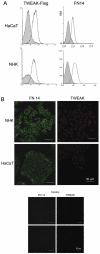
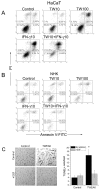
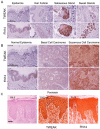
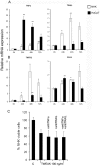
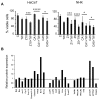

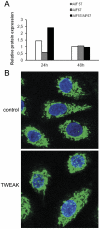
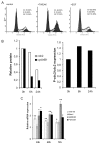
References
-
- Chicheportiche Y, Bourdon PR, Xu H, Hsu YM, Scott H, et al. TWEAK, a new secreted ligand in the tumor necrosis factor family that weakly induces apoptosis. J Biol Chem. 1997;272:32401–32410. - PubMed
-
- Bodmer JL, Schneider P, Tschopp J. The molecular architecture of the TNF superfamily. Trends Biochem Sci. 2002;27:19–26. - PubMed
-
- Wiley SR, Cassiano L, Lofton T, Davis-Smith T, Winkles JA, et al. A novel TNF receptor family member binds TWEAK and is implicated in angiogenesis. Immunity. 2001;15:837–846. - PubMed
-
- Wiley SR, Winkles JA. TWEAK, a member of the TNF superfamily, is a multifunctional cytokine that binds the TweakR/Fn14 receptor. Cytokine Growth Factor Rev. 2003;14:241–249. - PubMed
Publication types
MeSH terms
Substances
LinkOut - more resources
Full Text Sources
Research Materials
Miscellaneous

